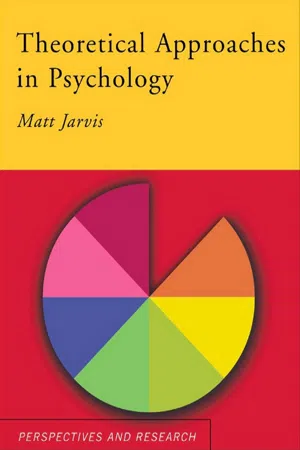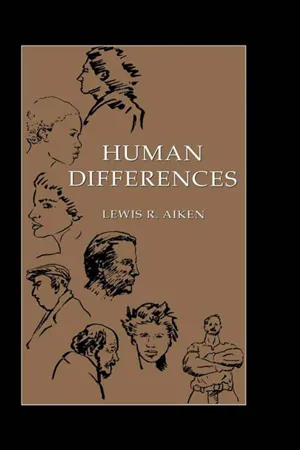Psychology
Biological Approach
The biological approach in psychology focuses on understanding behavior and mental processes through the lens of biology, genetics, and the nervous system. It emphasizes the role of genetics, brain structure, neurotransmitters, and hormones in shaping human behavior and psychological processes. This approach seeks to uncover the biological underpinnings of psychological phenomena.
Written by Perlego with AI-assistance
Related key terms
7 Key excerpts on "Biological Approach"
- Nancy Fenton, Jessica Flitter(Authors)
- 2015(Publication Date)
- Research & Education Association(Publisher)
Chapter 5 Biological Bases of BehaviorBiological psychology can be traced to the beginnings of psychology because it has its roots in physiology. The field of biological psychology , also called neuroscience , focuses on how genes, the nervous system, and the endocrine system influence behaviors and mental processes. Technological advances have allowed biological psychologists to provide a more complete understanding of what occurs on a physiological level during a psychological experience such as thinking or memory.Heredity, Environment, and EvolutionAn important aspect of the study of psychology is the interplay among genetic, environmental, and evolutionary influences. Complex human traits, such as intelligence, aggression, altruism, and personality, are influenced by all of these factors. For instance, psychologists attempt to determine how an individual’s level of aggression is impacted by inheritance and exposure to violence, as well as why aggressive tendencies were naturally selected.Biologists and psychologists are both interested in the various influences of nature and nurture on human traits. Biologists study physical traits, such as height and eye color, or susceptibility to diseases, such as cancer. In contrast, psychologists are interested in behavioral traits and psychological illnesses. Behavioral traits include aggression, intelligence, personality, etc.; psychological illnesses include anxiety, schizophrenia, depression, etc. The scientific discipline of behavioral genetics attempts to integrate the influences of heredity, environment, and evolution in terms of their effect on human behavior.HeredityBiological psychologists are interested in the study of heredity, or how the traits of parents are transmitted biologically to offspring. The nucleus of each human cell contains forty-six chromosomes , twenty-three donated by each parent. Chromosomes that determine gender are known as the X and Y chromosomes . One X chromosome is donated by the mother, and either an X or Y chromosome is donated by the father. An XX individual is female; an XY person is male. Each chromosome contains genes , which are made up of a chainlike molecule called deoxyribonucleic acid (DNA) . Each individual gene can be either dominant or recessive. A dominant gene takes precedence over a recessive gene for that particular trait. For the gene that determines eye color in humans, brown is the dominant gene and blue is the recessive gene. If either parent donates a dominant gene for eye color, the child will have brown eyes. If both parents donate recessive genes for eye color, the child will have blue eyes. A Punnett square can be used to predict the outcome of various traits. The genotype is the genetic makeup for a trait in an individual, which may or may not be expressed, while the observable characteristics of genes are referred to as the phenotype- eBook - ePub
- G Neil Martin, G Neil Martin(Authors)
- 2015(Publication Date)
- Routledge(Publisher)
Histology is the study of brain cells and their structure and activity. You will learn more about the study of cells later on in Chapter 2 and in the chapters on neuroanatomy and neurotransmission. Finally, psychoneuroimmunology refers to the study of the body's immune system processes and the ways in which they react to psychological variables. Psychoneuroimmunologists may, for example, look at the effect of stress on wound healing, the development of an illness or on the maintenance of good health; they may study variables that mediate these effects, such as sex, age, personality, ability to cope, and so on. All of these sub-areas – in themselves, large areas of study – come under the umbrella of biological psychology. 1.3 Biological Psychology's Approach to Behaviour Like all sciences, biology, psychology and biological psychology have their roots in the philosophy of the Ancient Greeks and were fashioned by the various philosophical schools of thought that developed from this. At the heart – and, indeed, the brain – of biological psychology is a phenomenon called reductionism (or biological reductionism). 1.4 Reductionism Reductionism refers to the idea that the subject matter of science can best be understood by reducing it to its smallest parts. Biological reductionism argues that we can only understand biological processes by looking at the physical components and mechanisms that give rise to these. Applying this approach to biological psychology, the prevailing view is that an organism's behaviour can best be understood – some biological psychologists argue, can only be understood – by studying the biological basis of behaviour. In effect, you are reducing the study of behaviour to its most basic building blocks: the cells, organs, systems and brain regions that give rise to behaviour - eBook - ePub
- Matt Jarvis(Author)
- 2005(Publication Date)
- Routledge(Publisher)
8 Biological psychology 1: genetic influences on behaviour
Key assumptions of the approach Behavioural genetics: the genetics of individual differences Evolutionary psychology: the genetics of human similarity Contemporary issue: does behavioural genetics pose a threat to other psychological approaches? Contributions and limitations of genetically based approaches SummaryKey assumptions of the approach
Have you ever wondered why a particular characteristic like high IQ or perhaps a bad temper seems to run in your family? Thinking about people more generally, have you ever considered why people prefer to go to the toilet alone, or why a young man going out with an older woman raises eyebrows whereas no one looks twice at an older man partnered with a young woman? Although there are many possible explanations for these patterns, there has recently been an upsurge of interest in biological explanations for these and many other psychological phenomena. Over the next two chapters we shall look at three major concepts from biology that have proved useful in explaining human psychology—genetics, evolution and neurophysiology.Genetics is the study of inheritance, and has been applied to psychology in looking at the extent to which psychological characteristics are affected by inheritance from parents. Evolution - eBook - ePub
- Ian Albery, Marcus Munafo(Authors)
- 2008(Publication Date)
- SAGE Publications Ltd(Publisher)
Physiology of Behavior (9th edition ). Needham Heights: Allyn and Bacon.A comprehensive introductory textbook which outlines the fundamentals of the biological basis of behaviour. Includes detailed coverage of the basic physiological sciences relevant to understanding behaviour.Goetz, A.T. and Shackelford, T.K. (2006) Modern application of evolutionary theory to psychology: key concepts and clarifications. American Journal of Psychology , 119, 567–584.Introduction to evolutionary psychology, which attempts to explain human behaviour with reference to why these behaviours evolved and were maintained due to survival pressures in our evolutionary past.See also biological and physiological models and biological basis of behaviour; biological and physiological models and twin, family and adoption studies; biological and physiological models and molecular genetics; biological and physiological models and psychoneuroimmunology; biological and physiological models and psychophysiologyBIOLOGICAL AND PHYSIOLOGICAL MODELS
and : TWIN, FAMILY AND ADOPTION STUDIESMEANING
For some time, we have known that development results from the dynamic interplay of nature and nurture. From birth onwards we grow and learn because our biology has programmed us to do so, because our social and physical environment provides stimulation, and because these factors interact with each other in what is increasingly being understood to be a subtle and complex way. Among the various human characteristics that are under both genetic and environmental influences are behaviours that may directly or indirectly relate to health, such as personality, smoking, drinking, and so on. Behaviour genetics refers to the study of the role of genetic influences on variation in behavioural traits such as these. Of course, by quantifying the genetic influence on these traits we also, indirectly, quantify the environmental influence, so behaviour genetics research gives us as much information about environmental influences as it does about genetic influences. Until relatively recently the only means by which the relative contribution of genetic and environmental variability in behavioural traits could be studied was by means of twin, family and adoption studies. Recent advances in molecular genetics - Nick Haslam, Luke Smillie, John Song(Authors)
- 2017(Publication Date)
- SAGE Publications Ltd(Publisher)
6 Biological Approaches Part 2: Brain Structure and FunctionLearning objectives
- To distinguish proximal biological influences on personality (i.e., brain structure and function) from distal biological influences on personality (i.e., evolution and genetics).
- To understand and describe major biological theories of personality in terms of the neural systems they identify as underlying personality traits.
- To appreciate the role that technology has played in the development of the field known as personality neuroscience.
- To identify the key challenges that personality neuroscience faces today.
Personality traits – like all other psychological and behavioural phenomena – are produced and constrained by biological processes in the brain. As the previous chapter demonstrated, genetic influences on personality are well established, and there are several ways in which these may have been shaped through evolution by natural selection. Nevertheless, evolutionary theory and genetics offer incomplete explanations of personality differences, because the mere existence of genetic influences does not illuminate the biological processes that underlie personality variation. Genes do not directly affect behavioural dispositions; they only do so indirectly by influencing brain development, brain structure, and brain chemistry. Genes code for the production of proteins that regulate brain functioning – indeed, about one-third of all our genes are expressed only in the brain – and if we want to account for the biological processes that directly underpin personality, it is at brain structures and functioning that we should look. Processes occurring in the brain directly explain why at any moment we might feel anxious, behave aggressively, or try hard to complete a difficult task. For this reason, a major goal of Personality Neuroscience- Dominic Upton(Author)
- 2013(Publication Date)
- Routledge(Publisher)
stressful living conditions or unemployment) or you may suggest some biological factors (such as the genes the individual inherited from their parents) (Anderson and Teicher, 2009). You may also come up with other suggestions – personality characteristics which make the individual prone to substance abuse or the reduction in tension and raised spirits that substance use may bring about (which could be broadly described as psychological factors) (Iigen et al, 2011). Indeed all of the variables you listed may simultaneously contribute to substance abuse/dependency behaviours. Of course, due to the complex nature of human behaviour it cannot be understood simply by one approach; we have to accept the inevitable – it is multi-faceted. Just as trying to explain a complex behaviour, like substance misuse, is confusing, so is trying to understand relatively simple behaviours such as arriving early or late for appointments or food preference. Within this chapter we will discuss the key psychological approaches and how these could be applicable within clinical practice. We will begin by examining the basic ideas underlying the psychodynamic approach. After reviewing the shortcomings of these ideas we will consider the assumptions of behaviourism and how these aimed to overcome the issues evident within the psychodynamic approaches. We will then proceed in examining social learning theory, which attempts to extend behaviourist ideas, before considering the cognitive approach. Finally, we will consider the humanistic approaches. Key message Attempting to understand the person by just one psychological perspective is impossible. 2.2 The psychodynamic approach The term ‘psychodynamic’ refers to a collection of theories that try to account for the dynamics of human behaviour; ‘dynamics’ are what drive us or motivate us to behave in particular ways. The psychodynamic approach explores how the mind (especially the unconscious mind) is responsible for everyday behaviour- eBook - ePub
- Lewis R. Aiken(Author)
- 2014(Publication Date)
- Psychology Press(Publisher)
11 To a monist, there is no such thing as a spirit world—a spiritual state separate from a living body. Mind and body, psyche and soma, are combined as a psychosomatic unity in human functioning and experience. To a monist, the construct of mind is not a distinct entity, but simply a function of brain dynamics. The brain is seen as the center of cognitive, affective, and psychomotor processes. It is the seat of consciousness and behavior and the regulator of the nervous system, the musculoskeletal system, the endocrine system, and other body structures.At the beginning of the 20th century, the older dualistic definition of psychology as the study of the mind was replaced by the definition of psychology as the science of human and animal behavior. A similar move toward monism was seen in medicine with the holistic concept of psychosomatic medicine. Psychosomatic medicine is based on the notion that thoughts and emotions can exacerbate and precipitate physical illnesses, and physical illness, in turn, can affect psychological functioning.Precipitated in some measure by advances in computing machines and neuropsychology, recently there has been a further modification of the definition of psychology to include cognitive processes. Psychology has been redefined as the study of behavior and cognition—a change that has been viewed by some as a return to mentalism or dualism. In any event, modern behavioral scientists recognize that behavior, cognitive processes, and personality are shaped and regulated by the structure and functioning of the human body. Understanding these influences and how they occur is the goal not only of modern psychology but also of many biologists, neuro-chemists, and health scientists.The purpose of this chapter is to provide an introduction to the ideas and findings of researchers in the natural sciences as they bear on our understanding of individual and group differences among people. This material is important to an understanding of the biological and biochemical substrates of cognitive, emotional, and psychomotor processes and, more generally, human personality. Because several of the remaining chapters of this book draw heavily on this material, the reader may wish to go beyond what is included here and refer to more detailed treatments of these topics in books on neuropsychology and behavior genetics (e.g., Kalat, 1998; Kolb & Whishaw, 1996; Plomin, 1994; Vernon, 1994).
Learn about this page
Index pages curate the most relevant extracts from our library of academic textbooks. They’ve been created using an in-house natural language model (NLM), each adding context and meaning to key research topics.






